The Language of Law: Interpreting Nineteenth-Century Legal Documents
The documentary record produced in the course of nineteenth-century American legal proceedings was truly enormous. Every court day in every town and city in the country, clerks and lawyers produced sheet after sheet of forms, complaints, deeds, warrants, and petitions. Millions of pages of legal paperwork sit in American courthouses and archives, often filed and stored according to their original legal logic. This vast archive remains one of the greatest sources for understanding the everyday lives of the middling and non-elite who otherwise rarely rise to the surface of the historical record. These documents though, frequently frustrate researchers as formulaic language and confusing tangles of proceedings and filings too often get in the way of constructing arguments and narratives about the historical subjects of the documents themselves. This paper looks at the digitized documentary archive produced by the O Say Can You See project (OSCYS) which includes over one thousand documents from freedom suits filed in Washington, D.C., from the 1800s to 1850s.1
The OSCYS database includes more than half a century of surviving case files in their entirety from the same court in a single kind of dispute, making it uniquely valuable to those interested in understanding the substance of each case as well as the stories they tell about larger processes. Documents produced for use in a courtroom, like those featured in OSCYS, always have multiple layers of meaning, each intended with different purposes and audiences in mind. Rather than focus on the substantive disputes and compelling stories featured in each individual case, this paper examines how the documents in the database functioned both as parts of a constrained set of legal procedures and as material texts representative of a wider genre.
Documents produced for use in a courtroom, like those featured in OSCYS, always have multiple layers of meaning, each intended with different purposes and audiences in mind.
The material form of the documents in the legal record can be particularly telling about the kinds of information and processes the legal establishment put the most value on. Though most American legal documents contain some vestige of handwriting into the twentieth century, it would be a mistake to view each of the 1,070 documents in the OSCYS database as a unique and separate creation. Lawyers and clerks relied heavily on formularies and guides, and by the late 18th and early 19th centuries, ever-cheaper print meant that nearly every routine legal procedure in major American cities had a corresponding printed form. Which legal processes deserved forms and which did not, as well as how different kinds of documents were produced, can suggest something about the frequency of these processes and how they were viewed by the legal establishment. For example, even a bird's-eye view of document images from the collection suggests how different modes of production and use characterize different kinds of documents and the time period in which they were produced. Compare, for example, this set of documents from the 1810s and 20s, showing a mix of handwritten and printed forms, mostly summonses:
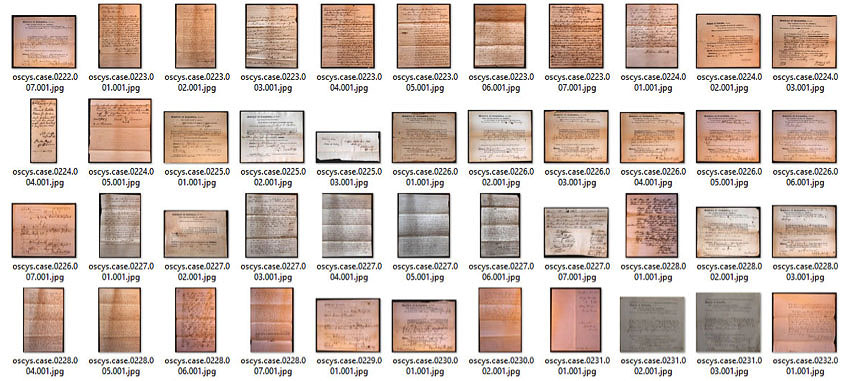
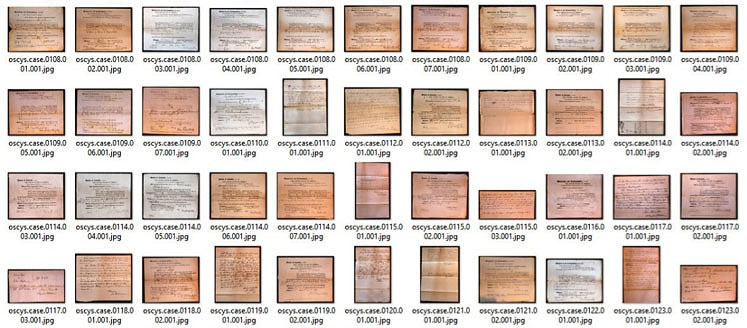
The OSCYS database includes over a thousand documents covering 255 different case files. Importantly though, only 38% of the case files in the OSCYS database include more than three documents, while only a few quite exceptional case files include more than ten documents. This means that the majority of the case files consist primarily of only a few standard documentary types. In fact, just two types of document— petitions for freedom and summonses—dominate the database, making up 68% of its total collection.
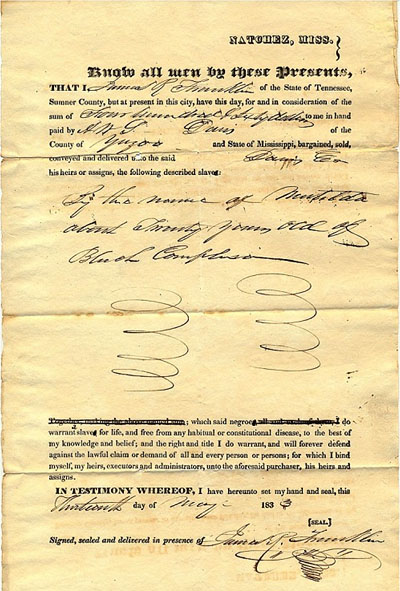
Legal Formularies
Most of the cases in the OSCYS database begin with petitions for freedom, making up about a fifth of all the documents in the archive (210/1,070).2 These petitions took many forms and are notably never characterized by the use of a printed form. This is no minor point, whereas forms existed for all manner of civil and criminal processes in the Anglo-American world, I know of none directly related to the petitioning for freedom of enslaved persons. This stands in noted contrast to the proliferation of forms which served to assist in the buying and selling of people under legal sanction, as seen to the right in a printed form made in Natchez, Mississippi specifically for the sale of enslaved people to residents of Sumner County, Tennessee. Thus when an enslaved person or his/her advocate went to court in order to petition for freedom, they were faced with the prospect of filling out a blank sheet of paper. This is not to say this was a particularly unusual task. Both before and after the age of mass-produced forms, lawyers and everyday citizens in small towns and cities wrote out their own legal documents. They did so largely based on guides and formularies which circulated in both manuscript and print.3 These guides included rote forms and easily copied text for everything from cattle theft, the submission of wolf pelts for bounty, the retrieval of sunken cargo, and how to prove a bastard child. Though manuscript formularies are difficult to track, a quick examination of printed form books shows the place of slavery and the law of freedom in popular legal consciousness.
Though no printed Washington, D.C., formulary appears until the later nineteenth century, formularies and guides from nearby Maryland and Virginia would have circulated widely and influenced legal knowledge on the subject of slavery. In various editions of a popular Maryland form book and guide, for instance, the only forms included dealing with slavery are bills and documents for confirming their purchase and sale.4 In their Virginia counterparts, whole chapters are dedicated to slavery-related forms and laws, and while the text of the Virginia statute relating to petitioning and proving freedom is included, all 39 sample forms provided relate to the policing of enslaved people, their apprehension, sale, and punishment.5 The process of petitioning for freedom was likewise only spelled out briefly in a 1796 Maryland statute which remained in force in the District of Columbia until the 1850s. In fact, the six sections in that statute begin with one explicitly limiting the jurisdiction of courts over these petitions and say only that such petitions could be offered.6 The beginning stage of petitioning then largely depended on the use by an enslaved petitioner of a lawyer specifically knowledgeable in this area of law.
Even though no form books for preparing these petitions seem to be available today, it's likely that the lawyers who handled these cases on a regular basis had an in-house style or formulary which they relied on, "filling in the blanks' so to speak as they produced each case.
Though no printed forms were available for petitions, a quick look at the language of the documents in the OSCYS set shows unsurprisingly that these documents were not composed de novo. While most scholars know to ignore phrases like "humbly sheweth" (which appears 83 times in the OSCYS petition set) as stock legal jargon, it is always tempting to read petitionary language like "entitled to [his/her/their] freedom" or "[unjustly/unlawfully/illegally] held in bondage" with microscopic precision and as powerful claims of the enslaved, when in fact, these phrasings are used in nearly half the petitions and have similar formulaic origins. In some cases, precise petitionary language can be traced to the style of a given attorney. For example, the particular phrasing "grant a subpoena to" (as opposed to other subpoena request phrasings) appears in 20 petitions for freedom, all but two of which were prepared by John J. Dermott. This is not to deny that important case-specific information can be gleaned from the petitions but that care needs to be taken in the interpretation of their language. Even though no form books for preparing these petitions seem to be available today, it's likely that the lawyers who handled these cases on a regular basis had an in-house style or formulary which they relied on, "filling in the blanks' so to speak as they produced each case. It makes sense then to pay close attention to the names, places, and other proper nouns in these documents while avoiding too deep an interpretation of the broad language of each petition on its own. In addition, it might enable researchers to pay special attention to those petitions which serve as outliers in the larger set, those, for example, which go well beyond the one-side of a sheet of paper typical in such a document.
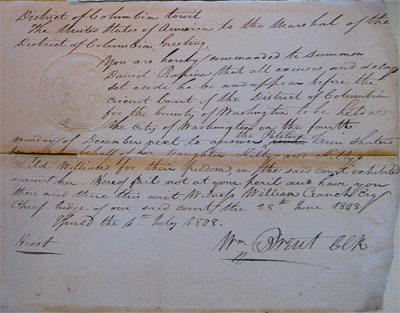
Petitions & Summonses
Petitions for freedom, though are only the second most frequently occurring document in the OSCYS collection. Nearly half of all of the documents contained in the database are summons/subpoenas (516 of 1,070)7. The summons was in a way the root of all Anglo-American legal process. Legal persons could not be swept up off the street and forced into court without a documentary trail; in this case, a summons duly served by a court officer to the putative slave owner him or herself. At any given court session, hundreds of summons would have been issued. Given this volume of business, by the early 19th century, the D.C. courts, like many around the country, turned to printed forms to ease the burden on clerical staff. These documents rested solely on the authority of the court which is exemplified in the printed portion of the form, with the details of the particular case filled out in manuscript. A summons largely says nothing about the legitimacy or merits of a case but nonetheless could serve as a powerful and perhaps surprising reversal of power for the putative slave holder—commanded by the court under penalty (subpoena) of fine to appear in order to answer the petition of a person otherwise deprived of most rights of personhood.
From the evidence in the OSCYS database, it appears that summonses were sent on the same day or soon after the submission of a petition for freedom. But one could perhaps examine more closely those cases in which there is a significant time lag between the two, as this could signal some machination or uncertainty within the court itself. Finally, the summons can also tell us one more thing about the parties involved in the case. The serving of a summons was no simple task: the marshal of the court had to first find the person complained against. In several of the D.C. cases included in the OSCYS database, repeated summons resulting from a petition for freedom went unanswered. In the case of Allen Seymour v. Nathan Seymour, for example, the marshal attempted to serve Nathan Seymour with notice of appearance on six different occasions stretching over three years, each time the verso of the printed summons is endorsed "Non est" i.e. not to be found. The ability of slave owners to evade summons could stymie the legal process for years and delay any justice for those petitioning for freedom. Though 45% of the case files in the database contain only two documents (largely one petition for freedom and one summons), the rest have additional documentation, and in a few cases, enough paperwork to carry a reader through the entire legal process. Given the diversity of other documents in the OSCYS set it's impossible here to examine each in detail but instead provide a guide to the course of a freedom case through the lens of the documents presented.
The ability of slave owners to evade summons could stymie the legal process for years and delay any justice for those petitioning for freedom.
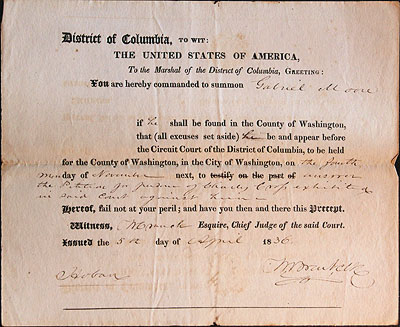
On March 19, 1830, Nelly Lemon, through her attorneys Coxe and Smith, petitioned for her and her children's freedom. The language of the petition includes very little beyond a statement of her claim to freedom. The summons was issued that same day, but per the endorsement on the back, the marshal did not successfully summon John Bayne, Lemon's putative owner. A second summons was issued that August, but this too failed. The case ground to a halt until 1832 when Lemon tried again, filing another petition with new attorneys. A new summons was issued the same day, and Bayne proved slippery again, failing to be found by the end of May. However, as is typical with court records, the surviving documentation doesn't tell the whole story. Bayne was apparently successfully summoned and the case tried during the June 1832 sessions of the court. This kind of lacuna is instructive—reading a case file chronologically will often result in gaps where a researcher is left to her imagination and inference to fill in the details.
Pre-Trial Documents
For some cases though, the OSCYS database includes pre-trial material such as depositions, affidavits, certificates and other supporting documentation. Depositions were official statements of fact solicited by attorneys in a case, sworn to by a witness, and submitted to the court. Similarly, affidavits were also sworn statements volunteered by members of the community or even the parties to the case themselves in hopes of securing a point of fact. Finally, interrogatories were lists of questions submitted by attorneys to be answered by witnesses relating to the facts at hand. Where they exist, interrogatories can prove to be the most detail-rich of any court document. Full of highly specific questions related to the background of the enslaved person and his/her claim to freedom, they frequently offer quotidian details about domestic life, conditions of enslavement, and family dynamics. These lists of questions, of course, were engineered by lawyers and the witnesses only answered what was asked of them—and not often wholly truthfully at that. Leading questions litter the documents in an attempt to spin the narrative one direction or another, such as this question on behalf of a slave owner: "Do you or do you not know that after the said sale and purchase the petitioner broke jail in the town of Alexandria and was a runaway for a considerable length of time thereafter."
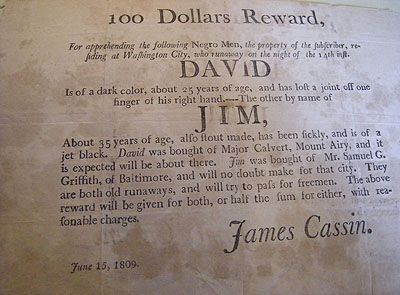
Exhibits
Some of the case files in the OSCYS database also include documentary exhibits presented to the court and the jury to aid one side or another. These exhibits often include some of the most fascinating and useful material for historians. Rather than documents designed formulaically for court use, many exhibits are bits and pieces of the everyday, and often ephemeral, documentary record which survive only because they were sucked into a legal process. This printed runaway slave advertisement from 1809 included as an exhibit in an 1811 case, for example, may very well be the only surviving copy of the document. In addition to pieces of ephemera like these, the exhibits contain copies of wills, deeds of manumission, and other legal documents now repurposed for new use as evidence. All of these pieces of evidence would be marshalled for service at trial by the attorneys for the petitioner(s) for freedom and the defendant wishing to keep the petitioner(s) enslaved.
Jury Instructions
The statute governing petitions for freedom in antebellum Washington stated that either of the parties could seek a trial by jury to decide the matter of freedom. However, by my count, only 42 of the 255 case files include evidence of a trial, the rest contain proceedings which either shed no light on the final disposition of a case or involve a settlement of some kind. This number is not terribly surprising, and if anything, is a bit on the high side for civil processes. In eighteenth-century commercial disputes, for example, as low as 15% of civil cases filed might make it to a verdict.8 Some records relating to juror selection do exist in the OSCYS files in which both parties had the opportunity to object to particular jurors but unfortunately the particular grounds for objection are rarely given. Some of the earlier digitized case files also include scans from the Circuit Court minute books (physically separate from the case files). These minutes of the Court's business on a given day usually include a list of the final jurors chosen as well as the outcome of the case, but precious little else. This is often one of the most dispiriting revelations to those new to legal document collections. Verbatim trial transcripts in lower civil court were almost never kept in this period and if done would have been made by a lawyer or newspaper reporter and published or distributed outside the aegis of the court itself. The record of the trial itself then is largely limited to any written objections made during its course, as well as any jury instructions written out and debated by the attorneys at hand.
Verbatim trial transcripts in lower civil court were almost never kept in this period. The record of the trial itself then is largely limited to any written objections made during its course, as well as any jury instructions written out and debated by the attorneys at hand.
Jury instructions exist for 14 of the cases in the OSCYS database and give valuable clues as to the legal reasoning and arguments at play in a dispute. For example, in the jury instructions submitted by Eleanora Bell and her attorney in an 1851 case, you can see pretty readily the direction the arguments in Court had gone. Bell's attorney reminds the jury that they must find that Bell was rightfully manumitted by her former owner if he was in sound mind at the time he wrote the document, regardless of how irrational he could be at other times. This suggests, of course, that a litany of witnesses or statements had been brought forward by the defendant to prove that her former owner was frequently not of sound mind. The existence of jury instructions in the archival record does not mean they were actually read to the jury. Several case files include jury instructions that were objected to by opposing counsel and sustained. Annotations in pencil, likely by a clerk of the Court, record the refusal of the instructions as in this 1835 example:

Appeal Documents
Finally, a last but quite important set of appeal documents appear in a small number of cases within the OSCYS set. By statute, appealing a verdict in a freedom suit required grounds based on errors in law rather than fact—i.e. issues such as proper legal process, correct jury instructions, and the validity of a statute. These cases, in the case of the District of Columbia, could be appealed to the Supreme Court on a writ of error. Quite helpfully, those cases seeking appeal had to provide a record of all prior court proceedings, a transcript record, copied out from the original court documents. In some cases, these transcript records include documents which don't survive in their original form and can provide a quick and convenient overview of an entire dispute.9
Because of their complexity, incompleteness, and often-formulaic nature, nineteenth-century court records like those in the OSCYS database have often gone unused or misused in disciplines outside legal history. By providing such a detailed and well-described set of original case files, the scholars behind the OSCYS database have given researchers the ability to see these documents on several different levels. Historians interested in the details of a given case can examine both the specifics of the case while also seeing the wider documentary context of the archive as a whole. Likewise, those interested in understanding legal processes on a macro level have the source base to examine changes over time in everything from documentary practices, to trial practice, to popular attitudes about freedom and slavery. It is my hope that exposure to this wealth of original documents in all their mundane, confusing, and occasionally surprising forms will inspire a host of new research questions and a better understanding across the broad historical community of just what the legal archive can and cannot tell us about the past.
Endnotes
2. Scholarship on freedom suits and the role of enslaved people in the courtroom has exploded in recent years through the work of Kelly Kennington, Kim Welch, Loren Schweninger, and Lea VanderVelde. See for a sampling of their work: Kennington, “Law, Geography, and Mobility: Suing for Freedom in Antebellum St. Louis” Journal of Southern History 80.3 (August, 2014), 575-604; Welch, “People at Law: Subordinate Southerners, Popular Governance, and Local Legal Culture in Antebellum Mississippi and Louisiana” (Ph.D. Dissertation, University of Maryland, 2012); VanderVelde, Redemption Songs: Suing for Freedom Before Dred Scott (Oxford University Press, 2014); and of course Schweninger’s groundbreaking Race & Slavery Petitions Project. [back]
3. For more on early modern copying and legal practice, see Harold Love, Scribal Publication in Seventeenth-Century England (Oxford: Clarendon Press, 1993) and Richard Ross, “The Memorial Culture of Early Modern English Lawyers: Memory as Keyword, Shelter, and Identity, 1560-1640,” Yale Journal of Law and the Humanities 10 (Summer 1998), 229-326. For an example of a late 18th-century American manuscript formulary see Fraas, “More than Formulaic” Unique at Penn (24 October 2012). [back]
4. The New American Clerk’s Magazine, and Complete Practical Conveyancer (Hagerstown, 1806), 111. [back]
5. The New Virginia Justice (Richmond, 1810), forms on 554-570, mention of the statutory provisions for freedom on 547. [back]
6. The relevant statute and sections can be found in Maryland Acts 1796, c. 67, § 21-26. For a direct rehashing of these provisions, see The Black Code of the District of Columbia: In Force September 1st, 1848 (Washington: William Harned, 1848), 30-1. [back]
7. I believe all of these summonses fit the broad criteria of a subpoena and not merely a civil summons or notice. [back]
8. William Offut, Jr., Of "Good Laws" and "Good Men": Law and Society in the Delaware Valley, 1680-1710 (Champaign: University of Illinois Press, 1995), 137-8. [back]
9. See, for example, Transcript Record, Ash v. Williams (March 1840). [back]



